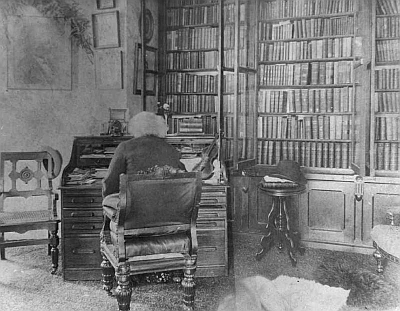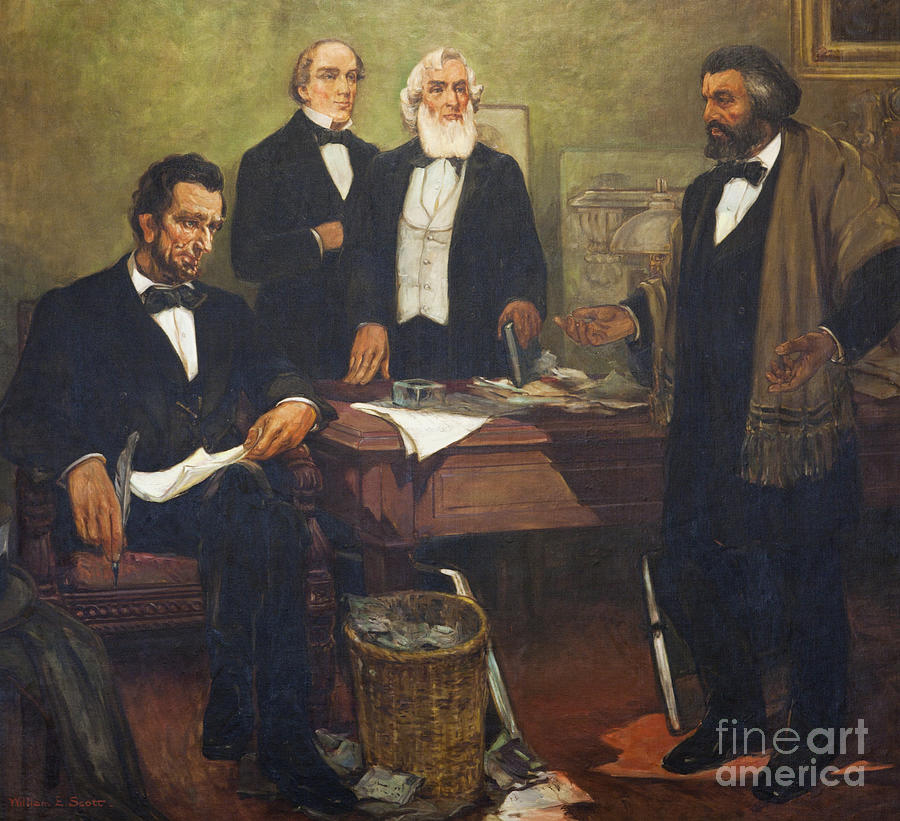Frederick Douglass

Garrett group:
Frederick Douglass, one of the most well-known abolitionists of American history, was born into slavery in Talbot County, Maryland. The son of a slave woman and white man (likely his mother’s master at the time), Douglass was raised by his maternal grandmother, and only saw his mother a few times before she died around his tenth year of life. After his master’s subsequent death, he was sent to Baltimore to serve Hugh Auld (the brother-in-law of his new master, Lucretia Auld). Here at the age of twelve he learned to read and write: first with the help of Sophia Auld (Hugh Auld’s wife), then secretly with the help of the poor white children in his neighborhood. Throughout these years, Douglass was a voracious reader, consuming everything that he could get his hands on. In his autobiography Narrative of the Life of Frederick Douglass, he mentions one piece titled The Columbian Orator as being particularly influential in shaping his abolitionist views, compounding his own desire to escape to freedom as well.
His time in Baltimore was interrupted by the death of his master, after which Douglass was sent back to Talbot County, and loaned to Edward Covey for one year. Covey was a “slave breaker,” tasked by Thomas Auld to “break in” Douglass for fieldwork. Douglass recounts his time serving Covey as being the most physically and psychologically taxing time of his life; Covey regularly beat all of his slaves, abusing them by any means possible. Douglass rebelled against one particular beating, physically overpowering Covey, a feat of courage that succeeded in ending Covey’s abusive streak against him. After his tenure under Covey ended, Douglass was leased out to William Freeland, and in his plantation he began holding Sunday school lessons teaching other slaves how to read and write.
Here he also planned his first attempt to escape up the Chesapeake Bay northward to freedom, along with two of his fellow slaves. Their plans were interrupted, resulting in Douglass being jailed for a short period of time. It wasn’t until two years later when he had returned to Baltimore to work as a caulker in a shipyard that he succeeded in escaping enslavement. In under 24 hours, traveling via food, steamboat, and train, Douglass went through Philadelphia (then a free “Quaker” city) up to New York City, where he wrote to his first wife Anna Murray (a free black woman who was still in Maryland) to join him. From there they traveled to New Bedford, Massachusetts, where they settled down. It was here that Douglass began his incredibly prolific career as an abolitionist and activist for women’s rights. In addition to his impactful literary works and documented orations, he also sat for numerous photographs, influencing society for generations by becoming an emblem of black excellence.
Douglass later married Helen Pitts after Anna’s death, moved to Rochester, New York, and finally settled in Cedar Hill, a property in the Anacostia neighborhood of Washington, D.C. that also extends into Maryland. Douglass died at home on February 20, 1895.

Frederick Douglass, reading inside his Cedar Hill Library
________________________________________________________________________________________________________________________
Special thanks to the students in Professor Ontiveros' ENGL142 class (Garrett group).
Image source: Cedar Hill Library.
________________________________________________________________________________________________________________________
Cecil group:
Frederick Douglass was born into slavery on a Talbot County plantation in 1818 (approximately). His mother was a slave who he rarely engaged with, while his father remained a mystery to him his whole life. As most slaves of the era were unable to read, Douglass sought out alternative methods and was able to teach himself how to read with the aid of his master’s wife, Sophia Auld, and other white children of the Baltimore locale. Such an education in literature ignited a flame within Douglass, and help foster his vehement opposition to slavery. As an avid reader of literature, he often wrote pieces that went on to express his opinions on human rights and treatment of his fellow slaves, opinions which he shared with other slaves and abolitionists.
In his autobiography “The Narrative of the Life of Frederick Douglass” (1845), Douglass depicts the cruelty of slavery and the struggles he went through physically and emotionally throughout his life. According to W.M. Lloyd Garrison “[The] Narrative contains many affecting incidents, many passages of great eloquence and power”. As an author, Douglass found amplesuccess in terms of sales. “The Narrative of the Life of Frederick Douglass sold '5000 copies' in 'four months' and My Bondage and My Freedom sold '15,000 copies' in 'two months'”. However, his later work failed to match such success. Douglass's revised edition of Life and Times sold only 399 copies in the first two years. Douglass purposely does not describe his escape from slavery in detail in order to protect other slaves who might attempt to do the same. It was through his escape in which met his future wife, Anna Murray, a free African American women who assisted him in his journey to freedom.

Through the brutality he endured as 20 years of being enslaved, Douglass become a powerful abolitionist and joined the fight to end slavery. He first spoke at smaller anti-slavery meetings and was then asked to become and official speaker of the Massachusetts Anti Slavery Society, where he began his life as an abolitionist. Not only did he fight against slavery, but he also supported women's suffrage after meeting Susan B. Anthony in 1845. Douglass was also known as the most photographed man in nineteenth-century America. He had various reasons for being photographed, one of which was to showcase the humanity of African-American people by “...show[ing] in two dimensions the contours of the anti slave, ‘God’s image in ebony,’ as the abolitionists like to say, who in essence and in possibility fundamentally, by definition, shares the blood of the blood and flesh of the flesh of every other white human being”. In addition, “Douglass was intent on the use of this visual image to erase the astonishingly large storehouse of racist stereotypes that had been accumulated in the American archive of anti black imagery”.
By the time the Civil War began in 1861, Douglass was already a well recognized African American. He used his pole position to augment the role of African Americans not only in the war, but also in the social climate across the country. Near the end of his life, Douglass was appointed U.S. Marshal for the District of Columbia by President Rutherford B. Hayes in 1877, later becoming the U.S. Minister resident and Consul General in 1889, until his death in 1895. Due to his many accomplishments, Douglass is often regarded as one of the most influential authors, politicians, and abolitionists born in Maryland.
________________________________________________________________________________________________________________________
Special thanks to the students in Professor Ontiveros' ENGL142 class (Cecil group).
Image source: Painting.
